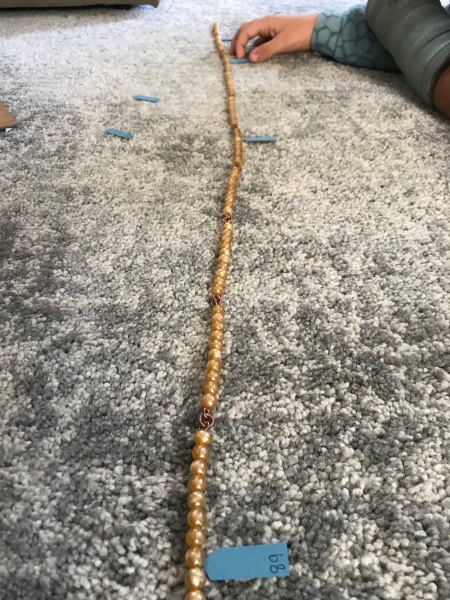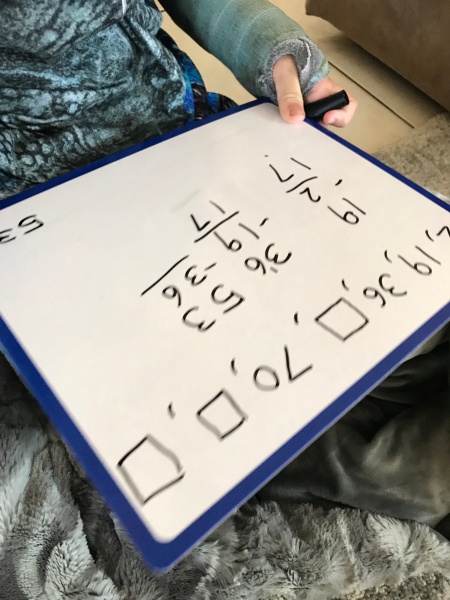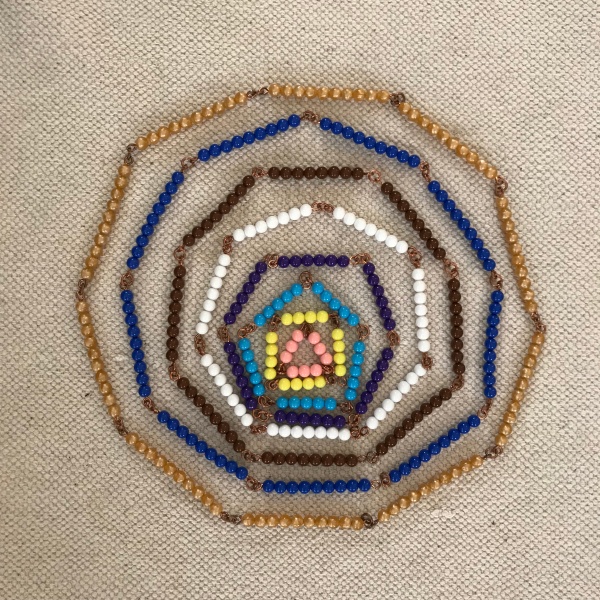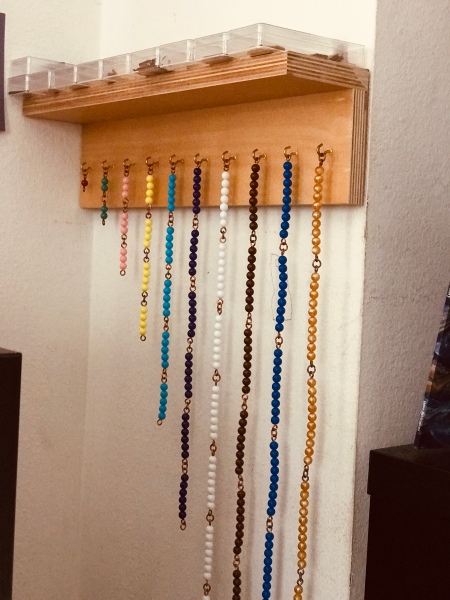Long Live the Short Chains
The Montessori Short Chains and Arrows pack a big learning punch and are often under-utilized. They're great for a homeschool environment because they don't take up any shelf space. Their initial purpose is to help the child first count linearly and then skip-count. But when your child is comfortable with these two concepts, you can use the chains for much more! Here are four ideas...
Find the number: Ask the child to set out the hundred chain with the corresponding arrows, while you cut up a few blank paper arrows (cut little rectangles and trim the corners to make arrows). Write a number on the arrow (any number between 1 and 99) and have the child place the arrow on the corresponding bead. If you notice mistakes, you can either let it be for now (and encourage more practice) or invite the child to count from the nearest tens-arrow (e.g. if the paper arrow says "26" and it's in the wrong spot, invite the child to count linearly from the "20" arrow). When they get comfortable with this activity, you can place blank arrows on random beads along the chain and ask the child to write down the numbers on the arrows. Later the child can do the same activities but without the tens arrows as guides. You can ask questions like, "What number would you reach if you added 10 beads to 26?" or "What number would you reach if you counted backwards 8 beads from 45?" You can do all these activities from around the age of 5 if counting skills are solid.

Find the missing number in a sequence: When a child knows how to skip-count, you can present a new challenge by having them find the missing number in a number sequence. The first few times you do this, you can use the regular arrows for any chain and hide one behind your back. Ask the child to lay out the arrows and tell you which one is missing. (e.g. The child lays out 5, 10, 20, 25 and tells you that 15 is missing.) Later, with the ten-chain, you write sequence numbers on paper arrows and the child has to use addition and subtraction to figure out the sequence and which numbers are missing. (e.g. Make arrows for the numbers 2, 19, 36, and 70 and the child has to lay them out and then figure out the pattern in the sequence and what number arrows are missing). Help the child verbalize the process he's using in order to solidify the concept and extend it to any number sequence without the material. The first part of this work is great from the age of five, and the sequence activity is great from six onwards, increasing in complexity.

Rounding to the nearest ten: The concept of rounding is not presented in isolation in the Montessori elementary, but is instead part of an ongoing conversation when working with money, estimating, etc. However, if a child isn't understanding the concept, you can use the hundred chain to support their comprehension. Have the child match the tens arrows to the bead chain, and then talk about how the tens are numbers that we can work with easily. Give examples of when we might want to work with numbers rounded to ten instead of exact numbers. Write the number 62 on a paper arrow and ask the child to place it on the corresponding bead on the chain. Then ask him what "ten" the arrow is closest to, and explain that 62 can be rounded down to 60 (or is closest to 60). Do the same with a couple of numbers with the units under 5. Then make an arrow with a number that has the units higher than 5 (e.g. 68). Ask the child what "ten" that number is closest to and point out that 68 rounds up to 70. Then write a number with 5 in the units (e.g. 65) and tell the child that our rule is that if a number has a 5 or above in the units, you round UP to the nearest ten. Give a couple of examples for the child and then encourage him to make his own examples. The book "Sir Cumference and the Roundabout Battle" has a lovely story that fits well with this activity.

Polygons: The chains provide a fun exploration of shapes, from triangle to decagon. Have the child carry all the chains on a tray to a large rug and ask her to make a closed shape with each chain imagining that the center was pressing out evenly on all sides. Then ask her how many sides each shape has. If you have a Geometry Cabinet, ask her to find the corresponding shape from the cabinet and put it inside or next to the bead shapes. The child can write on a slip of paper the number of sides each shape has, and then you can give the names. You can do a three-period lesson with a Primary child, and you can make an etymology chart with an Elementary child. The child can also build the shapes around each other, with the square surrounding the triangle, the pentagon surrounding the square, etc.
I hope these fun chain activities bring new life to your bead cabinet!
This post contains affiliate links.
Categories
- 3-6 (8)
- 6-9 (26)
- 9-12 (8)
- Positive Discipline (2)
- Conscious Parenting (12)
- Montessori Curriculum (9)
- Preparation of the Adult (14)
- Preparation of the Environment (11)
- Montessori Principles (11)
- Montessori Homeschooling (20)
- Language Arts (3)
- Math (3)
- Geography (2)
- Biology (1)
- History (2)
- Practical Life (1)
- Montessori Stories (4)


0 comments
Leave a comment